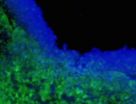Scientists engineer toxin-secreting stem cells to treat brain tumors
Proof-of-concept study highlights new therapeutic use of engineered human stem cells
2014-10-24
(Press-News.org) Harvard Stem Cell Institute scientists at Massachusetts General Hospital have devised a new way to use stem cells in the fight against brain cancer. A team led by neuroscientist Khalid Shah, MS, PhD, who recently demonstrated the value of stem cells loaded with cancer-killing herpes viruses, now has a way to genetically engineer stem cells so that they can produce and secrete tumor-killing toxins.
In the AlphaMed Press journal STEM CELLS, Shah's team shows how the toxin-secreting stem cells can be used to eradicate cancer cells remaining in mouse brains after their main tumor has been removed. The stem cells are placed at the site encapsulated in a biodegradable gel. This method solves the delivery issue that probably led to the failure of recent clinical trials aimed at delivering purified cancer-killing toxins into patients' brains. Shah and his team are currently pursuing FDA approval to bring this and other stem cell approaches developed by them to clinical trials.
"Cancer-killing toxins have been used with great success in a variety of blood cancers, but they don't work as well in solid tumors because the cancers aren't as accessible and the toxins have a short half-life," said Shah, who directs the Molecular Neurotherapy and Imaging Lab at Massachusetts General Hospital and Harvard Medical School.
"A few years ago we recognized that stem cells could be used to continuously deliver these therapeutic toxins to tumors in the brain, but first we needed to genetically engineer stem cells that could resist being killed themselves by the toxins," he said. "Now, we have toxin-resistant stem cells that can make and release cancer-killing drugs."
Cytotoxins are deadly to all cells, but since the late 1990s, researchers have been able to tag toxins in such a way that they only enter cancer cells with specific surface molecules; making it possible to get a toxin into a cancer cell without posing a risk to normal cells. Once inside of a cell, the toxin disrupts the cell's ability to make proteins and, within days, the cell starts to die.
Shah's stem cells escape this fate because they are made with a mutation that doesn't allow the toxin to act inside the cell. The toxin-resistant stem cells also have an extra bit of genetic code that allows them to make and secrete the toxins. Any cancer cells that these toxins encounter do not have this natural defense and therefore die. Shah and his team induced toxin resistance in human neural stem cells and subsequently engineered them to produce targeted toxins.
"We tested these stem cells in a clinically relevant mouse model of brain cancer, where you resect the tumors and then implant the stem cells encapsulated in a gel into the resection cavity," Shah said. "After doing all of the molecular analysis and imaging to track the inhibition of protein synthesis within brain tumors, we do see the toxins kill the cancer cells and eventually prolonging the survival in animal models of resected brain tumors."
Shah next plans to rationally combine the toxin-secreting stem cells with a number of different therapeutic stem cells developed by his team to further enhance their positive results in mouse models of glioblastoma, the most common brain tumor in human adults. Shah predicts that he will bring these therapies into clinical trials within the next five years.
INFORMATION:
This work was supported by the National Institutes of Health and the James S. McDonnell Foundation.
Cited: Stuckey, D. W. et al. Engineering toxin-resistant therapeutic stem cells to treat brain tumors. STEM CELLS. October 24, 2014.
[Attachments] See images for this press release:

ELSE PRESS RELEASES FROM THIS DATE:
2014-10-24
A new study has found that implementing stricter fisheries management overcame the expected detrimental effects of climate change disturbances in coral reef fisheries badly impacted by the 1997/98 El Niño, according to the Wildlife Conservation Society.
The 17-year study led by WCS fisheries scientists found that rapid implementation of fisheries restrictions countered adverse climate effects and actually increased fisheries catches, counter to predictions and findings in other studies without stricter management. This is good news for the millions of people who ...
2014-10-24
Physics researchers at Virginia Commonwealth University have discovered that most of the electrolytes used in lithium-ion batteries — commonly found in consumer electronic devices — are superhalogens, and that the vast majority of these electrolytes contain toxic halogens.
At the same time, the researchers also found that the electrolytes in lithium-ion batteries (also known as Li-ion batteries) could be replaced with halogen-free electrolytes that are both nontoxic and environmentally friendly.
"The significance [of our findings] is that one can have a ...
2014-10-24
Rockville, MD –Disaster Medicine and Public Health Preparedness Journal has released a novel, informative article that speaks to volunteers within the Ebola epidemic. The article, contributed by a consortium of Boston-based hospitals, is entitled Sign Me Up: Rules of the Road for Humanitarian Volunteers during the Ebola Outbreak. The authors paint an honest picture of volunteer circumstances, and ask those considering volunteering to not make the decision lightly. They insist that the "global healthcare community must and will rise to serve."
The World Health Organization ...
2014-10-24
NASA's TRMM satellite saw that Tropical Storm Ana was still generating moderate rainfall is it pulled away from Hawaii. The next day, NASA's Aqua satellite saw that wind shear was having an effect on the storm as it moved over open ocean.
On Oct. 24, Ana had moved far enough away from land areas that there were no watches or warnings in effect.
The Tropical Rainfall Measuring Mission (TRMM) satellite flew over tropical storm Ana on October 22, 2014 at 1935 UTC (about 8:30 a.m. HST local time). Ana formed over ten days ago but after moving to the northwest of the Hawaiian ...
2014-10-24
BUFFALO, N.Y. -- When partnering with larger companies, startups with a small number of carefully chosen alliances will reap the most benefits, according to new research from the University at Buffalo School of Management.
Forthcoming in Organization Science, the study found that by aligning with established companies, a young firm gains valuable access to additional resources and markets. However, as a startup adds more outside partners, eventually the firm's internal capability will weaken and the cost of maintaining its alliances will exceed any remaining benefits.
"Partnerships ...
2014-10-24
NOAA's GOES-East satellite has been keeping an eye on the remnants of Tropical Depression 9.
On Oct. 24 at 14:30 UTC (10:30 a.m. EDT) GOES-East captured a visible image of clouds and thunderstorms associated with former Tropical Depression 9,, centered over the southeastern Yucatan Peninsula of Mexico, Belize, and the adjacent northwestern Caribbean Sea.
NOAA's National Hurricane Center (NHC) noted that surface pressures were rising in the area, and the re-development of the former depression is unlikely. The remnants are expected to continue moving east over the ...
2014-10-24
Endurance athletes taking part in triathlons are at risk of the potentially life-threatening condition of swimming-induced pulmonary oedema. Cardiologists from Musgrove Park Hospital, Taunton, writing in the Journal of the Royal Society of Medicine, say the condition, which causes an excess collection of watery fluid in the lungs, is likely to become more common with the increase in participation in endurance sports. Increasing numbers of cases are being reported in community triathletes and army trainees. Episodes are more likely to occur in highly fit individuals undertaking ...
2014-10-24
A survey published this year found that over 50% of final year veterinary students in the UK do not feel confident either in discussing orodental problems with clients or in performing a detailed examination of the oral cavity of their small animal patients.1 Once in practice, things don't always improve and, anecdotally, it seems many vets dread feline dental procedures.
UK-based practitioners, Rachel Perry and Elise Robertson, who themselves felt woefully ill-prepared for feline dentistry as new graduates, have joined forces in an initiative to plug this educational ...
2014-10-24
The Ebola epidemic is continuing to spread, particularly in West Africa. According to the latest report by the World Health Organisation (WHO) dated 17 October, 9,216 cases of Ebola have been recorded and 4,555 people have died of the virus.
With the current situation of the Ebola epidemic, it quickly became necessary for French research to be mobilised rapidly.
In August 2014, the French Minister of Health and Secretary of State for Higher Education and Research made Aviesan responsible for preparing and organising the response of French research to infectious emergencies. ...
2014-10-24
A collaboration between researchers at the Universities of Leicester and Innsbruck has developed a completely new way of forming charged molecules which offers tremendous potential for new areas of chemical research.
Professor Andrew Ellis from our Department of Chemistry has been working for several years with colleagues at the Institute of Ion Physics in Austria on exploring the chemistry of molecules inside liquid helium. The team's latest and most startling discovery is that helium atoms can acquire an excess negative charge which enables them to become aggressive ...
LAST 30 PRESS RELEASES:
[Press-News.org] Scientists engineer toxin-secreting stem cells to treat brain tumors
Proof-of-concept study highlights new therapeutic use of engineered human stem cells




